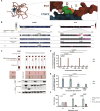Oncogene EVI1 drives acute myeloid leukemia via a targetable interaction with CTBP2
- PMID: 38748792
- PMCID: PMC11095456
- DOI: 10.1126/sciadv.adk9076
Oncogene EVI1 drives acute myeloid leukemia via a targetable interaction with CTBP2
Abstract
Acute myeloid leukemia (AML) driven by the activation of EVI1 due to chromosome 3q26/MECOM rearrangements is incurable. Because transcription factors such as EVI1 are notoriously hard to target, insight into the mechanism by which EVI1 drives myeloid transformation could provide alternative avenues for therapy. Applying protein folding predictions combined with proteomics technologies, we demonstrate that interaction of EVI1 with CTBP1 and CTBP2 via a single PLDLS motif is indispensable for leukemic transformation. A 4× PLDLS repeat construct outcompetes binding of EVI1 to CTBP1 and CTBP2 and inhibits proliferation of 3q26/MECOM rearranged AML in vitro and in xenotransplant models. This proof-of-concept study opens the possibility to target one of the most incurable forms of AML with specific EVI1-CTBP inhibitors. This has important implications for other tumor types with aberrant expression of EVI1 and for cancers transformed by different CTBP-dependent oncogenic transcription factors.
Figures





References
-
- Papaemmanuil E., Gerstung M., Bullinger L., Gaidzik V. I., Paschka P., Roberts N. D., Potter N. E., Heuser M., Thol F., Bolli N., Gundem G., van Loo P., Martincorena I., Ganly P., Mudie L., McLaren S., O’Meara S., Raine K., Jones D. R., Teague J. W., Butler A. P., Greaves M. F., Ganser A., Döhner K., Schlenk R. F., Döhner H., Campbell P. J., Genomic classification and prognosis in acute myeloid leukemia. N. Engl. J. Med. 374, 2209–2221 (2016). - PMC - PubMed
-
- Ottema S., Mulet-Lazaro R., Beverloo H. B., Erpelinck C., van Herk S., van der Helm R., Havermans M., Grob T., Valk P. J. M., Bindels E., Haferlach T., Haferlach C., Smeenk L., Delwel R., Atypical 3q26/MECOM rearrangements genocopy inv(3)/t(3;3) in acute myeloid leukemia. Blood 136, 224–234 (2020). - PubMed
-
- Groschel S., Sanders M. A., Hoogenboezem R., de Wit E., Bouwman B. A. M., Erpelinck C., van der Velden V. H. J., Havermans M., Avellino R., van Lom K., Rombouts E. J., van Duin M., Döhner K., Beverloo H. B., Bradner J. E., Döhner H., Löwenberg B., Valk P. J. M., Bindels E. M. J., de Laat W., Delwel R., A single oncogenic enhancer rearrangement causes concomitant EVI1 and GATA2 deregulation in leukemia. Cell 157, 369–381 (2014). - PubMed
-
- Smeenk L., Ottema S., Mulet-Lazaro R., Ebert A., Havermans M., Varea A. A., Fellner M., Pastoors D., van Herk S., Erpelinck-Verschueren C., Grob T., Hoogenboezem R. M., Kavelaars F. G., Matson D. R., Bresnick E. H., Bindels E. M., Kentsis A., Zuber J., Delwel R., Selective requirement of MYB for oncogenic hyperactivation of a translocated enhancer in leukemia. Cancer Discov. 11, 2868–2883 (2021). - PMC - PubMed
MeSH terms
Substances
LinkOut - more resources
Full Text Sources
Medical
Molecular Biology Databases
Research Materials

